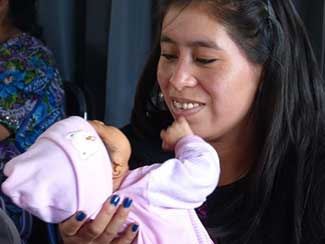Cultural factors influence breastfeeding practices
May / June 2021 | Volume 20 Number 3
 Photo by Carla Mattal/HEP+
In some countries, women give babies honey or sugar water before initiating breastfeeding.
Photo by Carla Mattal/HEP+
In some countries, women give babies honey or sugar water before initiating breastfeeding.
By Susan Scutti
Infants in low-resource settings may be malnourished and are likely to endure numerous intestinal infections in the first years of life. To better understand how that affects their health and development, an international team working in eight low- and middle-income countries (LMICs) followed about 2,000 newborns for their first two years of life. Known as
MAL-ED, the Etiology, Risk Factors and Interactions of Enteric Infections and Malnutrition and the Consequences for Child Health and Development project was funded by the Bill and Melinda Gates Foundation and co-led by Fogarty and the Foundation for the NIH. The program - begun in 2009 and still generating publications - operated study sites in Bangladesh, Brazil, India, Nepal, Pakistan, Peru, South Africa and Tanzania.
“MAL-ED was designed to characterize very carefully the diet of the child, including breastfeeding and the introduction of complementary foods, as well as to characterize gut health,” explained Dr. Laura Caulfield, one of the project’s 120 principal investigators.
An examination of breastfeeding practices was included at all eight study sites. Despite WHO recommendations for exclusive breastfeeding for the first 180 days of life, the vast majority of babies - 81% - transitioned to other forms of nutrition before that. Typically, exclusive breastfeeding lasted about a month before animal milks were introduced, quickly followed by solids. “The public health community also recommends breastfeeding be initiated in the first hour, which is best in terms of establishing a mother’s milk supply and helps with neonatal adjustment to the extra-uterine environment,” said Caulfield. Adoption of that guidance varied by country from 41% to 82%. (see
Breastfeeding Practices chart)
Beyond nutrients, breast milk contains substances that foster growth and development, plus a host of immune factors that decrease the likelihood of pathogens causing disease, explained Caulfield.
Breastfeeding Practices
| Research site | Breastfeeding
within hour
of birth | Prelacteal
feeding |
|---|
| Bangladesh | 62% | 13% |
|---|
| Brazil | 45% | 6% |
|---|
| India | 61% | 12% |
|---|
| Nepal | 41% | 18% |
|---|
| Peru | 75% | 8% |
|---|
| South Africa | 59% | 2% |
|---|
| Tanzania | 82% | 4% |
|---|
Note: Pakistan did not report data
Source: Data from the MAL-ED study.
A common impediment to exclusive breastfeeding is prelacteal feeds - the idea that you must give something to the baby before you start breastfeeding, such as honey or sugar water, explained Caulfield. This delays initiation, which in turn may limit production of a mother’s milk. “In Pakistan a large majority of babies have prelacteal feeds,” said Caulfield. “It’s very culturally driven.”
Colostrum - the earliest breast milk produced after birth which is thought to be “unclean” in some cultures given its yellow color - was fed to a large majority of babies, more than 90% at each site. Yet, the practice of discarding colostrum still persists in some places, including Peru, according to another Fogarty-funded study.
Possibly the most insightful MAL-ED paper examined the fact that women go in and out of exclusive breastfeeding all the time, said Caulfield. Most mothers, for example, will need to go somewhere and so ask family or neighbors to feed their infants. The study’s finding suggests the difficulty in “how you support women who are breastfeeding, and, if there have been gaps, how do you help a woman re-establish her milk supply so that she can successfully return to exclusive breastfeeding,” said Caulfield.
The central finding of the MAL-ED study surprised researchers: pervasive, low-level exposure to pathogens - and not necessarily having diarrhea or becoming ill - was associated with underdevelopment. Caulfield said that was disconcerting “because in essence we were saying that it’s not really getting ill but ‘under the iceberg’ kinds of things that cause growth faltering leading to stunting.”
More Information
-
Malnutrition and Enteric Disease Study (MAL-ED)
- Findings from MAL-ED:
The significant role of malnutrition, intestinal infection and disease on child development
Q and A with Michael Gottlieb, Ph.D., FNIH deputy director of science
Foundation for NIH news, October 11, 2017 -
How multiple episodes of exclusive breastfeeding impact estimates of exclusive breastfeeding duration: report from the eight-site MAL-ED birth cohort study
Maternal and Child Nutrition, October 2016 -
Characteristics associated with the transition to partial breastfeeding prior to 6 months of age: Data from seven sites in a birth cohort study
Maternal and Child Nutrition, July 2021 -
Prelacteal feeding practices in Pakistan: a mixed-methods study
International Breastfeeding Journal, Jun 8, 2020 -
Home birth preference, childbirth, and newborn care practices in rural Peruvian Amazon
PLoS One, May 4, 2021 -
Relationship between growth and illness, enteropathogens and dietary intakes in the first 2 years of life: findings from the MAL-ED birth cohort study
BMJ Global Health, December 28, 2017 -
Profile: Dr. Laura Caulfield via Johns Hopkins Bloomberg School of Public Health
To view Adobe PDF files,
download current, free accessible plug-ins from Adobe's website.
Related World Regions / Countries
Related Global Health Research Topics